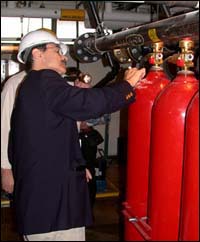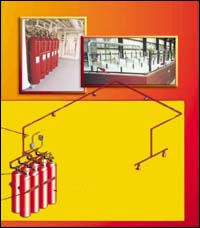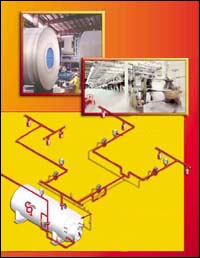Shipyard Employment eTool
Fire Protection >> Fixed Fire Extinguishing System Hazards on Board Vessel

The following information has been developed to help employers and employees develop an effective fire protection program. This involves protecting shipyard employment workers from fire hazards while conducting ship repair, shipbuilding, shipbreaking, and related work activities as well as firefighting activities. Many of the basic tasks involved in shipyard employment, such as welding, grinding, and cutting metal with torches, provide an ignition source for fires.
There are also many combustible materials on vessels and in shipyards, including flammable fuels, cargo, wood structures, building materials, and litter. When torches are used in confined or enclosed spaces, accidents resulting in oxygen-enriched atmospheres can cause normally fire-resistant materials to readily burn. When fires do occur, employees are often working in confined or enclosed spaces making escape difficult or impossible. Fires in such confined or enclosed spaces can also result in atmospheres of combustible gases, toxic fumes, or oxygen-deficient air or super-heated air.


Potential Hazards
- Accidental discharge of fire extinguisher.
- Miscommunication and coordination with:
- Ship owner and prime contractor
- Prime contractor and subcontractor
Requirements and Example Solutions
- When active fixed extinguishing systems could create a dangerous atmosphere in vessels and vessel sections: [1915.506(a)]
- Physically isolate the system or use other positive means to prevent the systems' discharge. [1915.506(b)(1)]
- Ensure that employees are trained to recognize: [1915.506(b)(2)]
- Systems' discharge, evacuation alarms and appropriate escape routes. [1915.506(b)(2)(i)]
- Hazards associated with the extinguishing systems and agents including the dangers of disturbing system components and equipment (such as piping, cables, linkages, detection devices, activation devices, and alarm devices). [1915.506(b)(2)(ii)]
- During sea and dock trials, all systems must remain operational. Ensure that: [1915.506(c)]
- All doors, hatches, scuttles, and other exit openings remain working and accessible for escape in the event that the systems are activated. [1915.506(d)(1)]
- All inward opening doors, hatches, scuttles, and other potential barriers to safe exit are removed, locked open, braced, or otherwise secured. [1915.506(d)(2)]
- When testing a fixed extinguishing system, all workers must be evacuated from the space during discharge. Oxygen level must be tested to ensure safe conditions prior to workers reentering the space. [1915.506(e)]
- Fixed extinguishing system must be physically isolated before conducting maintenance on the system. [1915.506(f)]
- When fixed manual extinguishing systems are used to provide fire protection for spaces in which work must be performed, ensure that: [1915.506(g)]
- Only authorized workers are allowed to activate the system. [1915.506(g)(1)]
- Authorized workers are trained to operate and activate the systems. [1915.506(g)(2)]
- All workers are evacuated from the protected spaces, and accounted for, before the fixed manual extinguishing system is activated. [1915.506(g)(3)]

